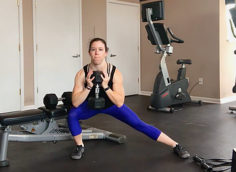The Deadlift and the Need For Stiffness
During the deadlift our torso – everything above the pelvis – is statically loaded. This means that the job of our torso is to hang on for dear life and not move. All of our movement comes from the hips and legs.
As such, the biggest reason we fail at higher intensities is because of a lack of "stiffness" generated by the torso and the anterior core: the deep and superficial abdominals, obliques, lats, erectors, etc. This stiffness is what allows us to maintain a neutral lumbar spine and to avoid energy leaks at our pivotal joint systems.
As advanced lifters, as soon as we sense our lumbar spine compromising its neutral alignment, we drop the bar. We don't even have to think. Reciprocal inhibition kicks in to protect us, and that'd be all she wrote.
So it stands to reason that methods focusing on the ability to continually increase stiffness at the intra-thoracic region during our reps will result in less reciprocal inhibition and heavier deadlifts. This is where a new breathing technique comes in to improve our strength performance.
Breathing for Strength
Essentially, the key to pulling big numbers safely is all about breathing. Think about the diaphragm, our primary breathing muscle, as being a parachute that's surrounded by abdominal walls. When we inhale, in order to create space for the diaphragm to expand, our abdominal wall stretches. When we exhale, the opposite happens and our abdominal wall contracts in order to apply pressure on the diaphragm and force the air out.
So how does this apply to training? As it turns out, you can use a balloon to learn how to breath during a deadlift. The result? Bigger, safer pulls.
Balloon Breathing Exercise
- Get yourself a balloon and a short straw. Prior to deadlifting, get on your back with your feet up against the wall.
- Insert the straw into the balloon and exhale for as long and hard as you can, trying to fill the balloon. Aim for anywhere between seven and twelve seconds.
- Once you've pumped out every ounce of oxygen you have (and I mean until your eyes are bloodshot and your cheeks are purple), clamp down on the straw so that the balloon doesn't deflate. Now inhale through the nose into the diaphragm (trying not to chest-breathe), and repeat.
- When the balloon is totally full, let the air fart out and do it all one more time.
This drill will only take a minute or two. The first time you perform this exercise, you'll develop so much tension in the abs that you'll feel like you're about to pop a rib. The straw ensures that the exhalation must be long, allowing for a deeper abdominal contraction. The balloon ensures that the breath is powerful. Try to get to the point where you can fill it up in a single blow.
The balloon and straw work together to greatly increase your capacity to generate stiffness at the anterior core and lumbar spine, and most importantly, to greatly increase the speed with which you can generate that stiffness. Once you get good enough to blow the balloon up fast, with a single exhalation you'll be able to quickly generate all the stiffness you need for good bar speed, no matter the load.
Taking This New Skill to the Bar
Generate stiffness in the same way you did in the balloon drill and you'll find that your nervous system is primed for an incredible pull. Begin the exhalation just before you start to drive the bar and notice how solid you feel. Try to perform the entire rep in a single exhalation.
Master this and you'll be training the deadlift without sacrificing intra-thoracic pressure or the oxygenation of your working tissues. As a result, you'll also develop less lactic acid and hydrogen-ion build-up and be physically prepared for the next rep.





